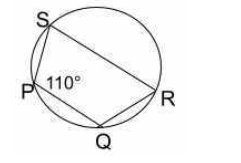PQRST is a cyclic pentagon and PT is a diameter, then ∠PQR+∠RST is equal to the
180∘
270∘
216∘
144∘
The correct Answer is:B
To solve the problem, we need to find the sum of the angles ∠PQR and ∠RST in the cyclic pentagon PQRST where PT is a diameter.
1. Understanding the Cyclic Pentagon:
- A cyclic pentagon is a polygon whose vertices lie on the circumference of a circle. In this case, PQRST is a cyclic pentagon with PT as the diameter.
2. Identifying Angles:
- We need to find ∠PQR and ∠RST.
- Let's denote ∠PQR as x and ∠RST as y.
3. Using the Inscribed Angle Theorem:
- The inscribed angle theorem states that an angle inscribed in a semicircle is a right angle. Since PT is the diameter, both ∠PQR and ∠RST subtend the arc PR and RT respectively.
4. Setting Up the Equations:
- From the properties of cyclic quadrilaterals, we know that the opposite angles sum up to 180∘. Thus, we can express this as:
x+y=180∘
5. Finding the Values of Angles:
- Since PT is the diameter, ∠PQR and ∠RST are both inscribed angles that subtend the same arc PR and RT.
- Therefore, we can conclude that:
x=y
- Substituting y with x in the equation gives:
x+x=180∘⟹2x=180∘⟹x=90∘
6. Calculating the Total:
- Since both angles ∠PQR and ∠RST are equal:
∠PQR+∠RST=90∘+90∘=180∘
Final Answer:
Thus, ∠PQR+∠RST=180∘.
- A cyclic pentagon is a polygon whose vertices lie on the circumference of a circle. In this case, PQRST is a cyclic pentagon with PT as the diameter.
- We need to find ∠PQR and ∠RST.
- Let's denote ∠PQR as x and ∠RST as y.
- The inscribed angle theorem states that an angle inscribed in a semicircle is a right angle. Since PT is the diameter, both ∠PQR and ∠RST subtend the arc PR and RT respectively.
- From the properties of cyclic quadrilaterals, we know that the opposite angles sum up to 180∘. Thus, we can express this as:
x+y=180∘
- Since PT is the diameter, ∠PQR and ∠RST are both inscribed angles that subtend the same arc PR and RT.
- Therefore, we can conclude that:
x=y
- Substituting y with x in the equation gives:
x+x=180∘⟹2x=180∘⟹x=90∘
- Since both angles ∠PQR and ∠RST are equal:
∠PQR+∠RST=90∘+90∘=180∘
Thus, ∠PQR+∠RST=180∘.
Topper's Solved these Questions
- GEOMETRYBook:KIRAN PUBLICATIONChapter:GEOMETRYExercise:QUESTIONS ASKED IN PREVIOUS SSC EXAMS (TYPE-IX)
Explore 5 Videos
- GEOMETRYBook:KIRAN PUBLICATIONChapter:GEOMETRYExercise:QUESTIONS ASKED IN PREVIOUS SSC EXAMS (TYPE- X)
Explore 25 Videos
- GEOMETRYBook:KIRAN PUBLICATIONChapter:GEOMETRYExercise:QUESTIONS ASKED IN PREVIOUS SSC EXAMS (TYPE-VII)
Explore 6 Videos
- DISCOUNTBook:KIRAN PUBLICATIONChapter:DISCOUNTExercise:Test Yourself
Explore 10 Videos
- LCM AND HCF Book:KIRAN PUBLICATIONChapter:LCM AND HCF Exercise:Test Yourself
Explore 18 Videos
Similar Questions
Knowledge Check
PQRST is cyclic pentagon and PT is a diameter, then ∠(PQR)+∠RST is equal to
A180∘B270∘C216∘D144∘PQRST is a regular pentagon. If PR and QT intersects each other at X, then what is the value (in degrees) of ∠TXR?
A98B90C72D108ABCD is a cyclic quadrilateral and AD is a diameter. If ∠DAC=55∘ then value of ∠ABC is
A55∘B35∘C145∘D125∘
In the given figures, PQRS is a cyclic quadrilateral. What is the measure of the ∠PQR, if PQ is parallel to the SR?

View SolutionDraw a triangle PQR with ∠ PQR is equal to 90∘.
View SolutionPQRS is a cyclic quadrilateral such that PR is a diameter of the circle. If ∠QPR=67∘and∠SPR=72∘, then ∠QRS=
(a)41∘ (b) 23∘ (c) 67∘ (d) 18∘
View SolutionPQRS is a cyclic quadrilateral and PQ is the diameter of circle . If ∠RPQ=38∘ , what is the value (in degrees) of ∠PSR ?
View SolutionPQRS is a cyclic uadrilateral such that PR is the diameter of the circle. If ∠QPR=50∘ and ∠SPR=60∘, then ∠QRS=…….
View Solution

